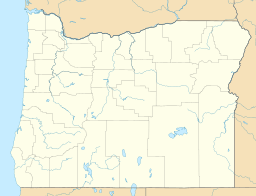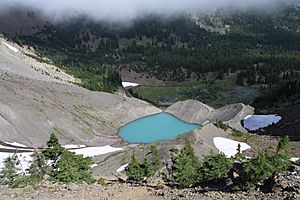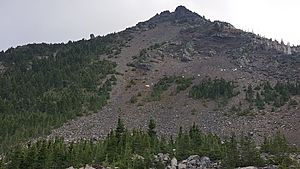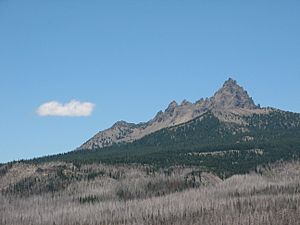Three Fingered Jack facts for kids
Quick facts for kids Three Fingered Jack |
|
|---|---|
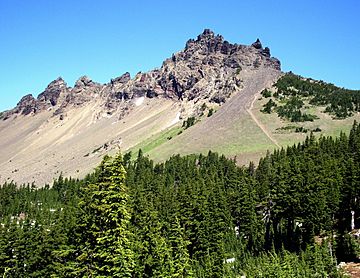
Southwest side of Three Fingered Jack seen from Pacific Crest Trail
|
|
| Highest point | |
| Elevation | 7,844 ft (2,391 m) NAVD 88 |
| Geography | |
| Parent range | Cascades |
| Topo map | USGS Three Fingered Jack |
| Geology | |
| Age of rock | older than 200,000 years |
| Mountain type | Summit, Shield volcano |
| Volcanic arc | Cascade Volcanic Arc |
| Last eruption | Pleistocene |
| Climbing | |
| First ascent | 1923 by E. McNeal and party |
Three Fingered Jack is a tall mountain peak in the Cascade Range in Oregon, U.S.. It is actually an old shield volcano, which means it has wide, gently sloping sides. This mountain formed a very long time ago, during the Pleistocene ice age. It is made mostly of a type of lava called basaltic andesite. In the past, huge glaciers covered it.
Even though many other Oregon volcanoes that had glaciers now have sharp, eroded cores, Three Fingered Jack's top is a narrow ridge. This ridge is made of loose rock pieces called tephra and is held up by a strong rock wall, or dike, that is about 10 feet (3.0 m) thick. The glaciers helped show off these dikes and other rock formations. The volcano has not been active for a very long time and is now quite worn down by nature.
The area around Three Fingered Jack is home to many different plants, animals, and fungi. The Molala people, who are Native Americans, lived here long ago. They fished for salmon and gathered berries, fruits, and special rocks like obsidian. The first non-Native American to visit the area was David Douglas in 1825. The first group to climb to the very top of the volcano did so in September 1923. People still climb Three Fingered Jack today, but it can be tricky in bad weather.
Contents
Where is Three Fingered Jack?
Three Fingered Jack is located in Oregon, in both Linn and Jefferson counties. It is a large mountain, about 2.4 cubic miles (10 km3) in size. Its highest point is 7,844 feet (2,391 m) above sea level. This jagged mountain stands between Mount Jefferson and the Three Sisters volcanoes.
You can find Three Fingered Jack inside the Mount Jefferson Wilderness. This means you can only reach it by walking on trails, like the famous Pacific Crest Trail. It is about 20 miles (32 km) northwest of the city of Sisters and is a well-known sight in the area.
Land Features Around the Volcano
During the last big ice age, called the Wisconsin glaciation, glaciers shaped the land around Three Fingered Jack. They left behind piles of rock and dirt called moraines. You can also see scratches on the rocks, called glacial striations, which show where the ice moved.
Today, only one small glacier remains on the volcano, called Jack Glacier. It sits in a shady bowl on the northeast side. This glacier is quite small, about 2.5 acres (1.0 ha), but it used to be much larger. It is likely not moving much anymore.
A lake formed behind one of the moraines left by Jack Glacier. This lake is about 26 feet (8 m) deep. It was first written about in 1937. The moraines holding back the lake are steep and rocky. Sometimes, parts of these moraines have broken, causing floods down the mountain. This happened several times, including a big flood in 2012. The soil on the volcano is thin and covered by ash from past eruptions.
Plants and Animals
Three Fingered Jack is home to many different kinds of plants and animals.
Plants
Along the volcano and its hiking trails, you can find trees like Douglas fir, Alpine fir, blue spruce, and mountain hemlock. There are also plants like bear grass and Cascade parsley fern.
Animals
Many animals live in the wilderness around Three Fingered Jack.
- Mammals: You might see American black bears, coyotes, cougars, and red foxes. There are also deer like Roosevelt elk and mule deer. Smaller mammals include American pikas, snowshoe hares, and various rodents like yellow-bellied marmots and North American beavers. Mountain goats also live on the rocky slopes.
- Birds: Many bird species fly around the mountain. Some common ones are mallards, red-tailed hawks, great horned owls, and Northern flickers. You might also spot Steller's jays, common ravens, American robins, and pine siskins.
- Amphibians and Reptiles: In the wetter areas, you can find long-toed salamanders, rough-skinned newts, and tailed frogs. Reptiles like pygmy short-horned lizards and common garter snakes also live here.
How Three Fingered Jack Formed
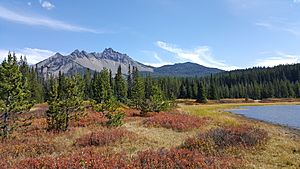
Three Fingered Jack is a shield volcano, which means it has a broad, gently sloping shape. It is one of several volcanoes in Oregon known as "Oregon's Matterhorns" because their sharp, rocky peaks look a bit like the famous Matterhorn mountain in Switzerland.
This volcano, along with others like Mount Thielsen and Mount Washington, had a shorter life than bigger volcanoes in the Cascade Range. It stopped erupting over 100,000 years ago. Three Fingered Jack is the northernmost of these "Matterhorn" volcanoes.
The High Cascades in Oregon are made up of many shield volcanoes and cinder cones. Three Fingered Jack itself has several overlapping cinder cones and composite cones built on top of older lava flows. These volcanoes and their lava cover an area of about 34 square miles (88 km2).
The main part of the volcano is made of light gray lava. Inside these lava flows, you can find different colored volcanic rocks. Scientists have studied the lava to understand where it came from deep inside the Earth.
Even though Three Fingered Jack doesn't have a solid rock plug at its very top, its summit sits on a cone of loose volcanic rock. There are also other smaller cones and craters on its sides. Some nearby volcanoes, like Maxwell Butte and Turpentine Peak, are also shield volcanoes. Other volcanic cones in the area include Duffy Butte, Hogg Rock, Marion Mountain, and Red Butte.
The volcano has a long, north-to-south ridge that looks like a saw blade. It is very eroded, meaning wind and ice have worn it down a lot. This ridge is made of loose volcanic ash and rock, held up by a 10 feet (3.0 m) thick rock wall. Some climbers even say the summit feels like it moves in the wind because it's so loose! Glaciers during the ice ages carved out the mountain, showing its inner layers and helping scientists learn about its past eruptions. Scientists believe the volcano is between 500,000 and 250,000 years old.
Volcano's Past Eruptions
Three Fingered Jack's eruption story is similar to many other volcanoes in the High Cascades. It started with a cone of loose volcanic rock forming over older shield volcanoes. Later, more eruptions created the main volcanic cone with lava flows and more loose rock.
The volcano is thought to be between 500,000 and 250,000 years old. As it got older, its eruptions became more explosive. These powerful eruptions created a lot of loose rock, which is why the summit and upper cone are so unstable today. The lava flows near the top are about 3 feet (0.91 m) thick.
The volcano stopped erupting before the last big ice age. This allowed the huge glaciers to wear away most of the cone, especially on its eastern and northeastern sides. Even after Three Fingered Jack became inactive, other volcanoes between it and the Three Sisters continued to erupt. These eruptions, which happened after Mount Mazama exploded about 6,600 years ago, covered large areas with ash and lava.
People and the Mountain
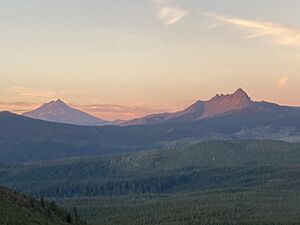
The Molala people lived in the area around Three Fingered Jack for a very long time. They were skilled at fishing for salmon and gathering berries, fruits, and special rocks like obsidian. Not much is known about their daily lives and traditions.
The first non-Native American explorers to visit this region were David Douglas in 1825 and Peter Skene Ogden in 1826.
The first group to successfully climb to the top of Three Fingered Jack was on September 3, 1923. This group included Ervin McNeal, Phil Philbrook, Armin Furrer, Wilbur Watkins, Leo Harryman, and Ronald Sellars.
The name "Three Fingered Jack" has a few possible stories. Some say it was named after a gold miner from the California Gold Rush who was also called Three Fingered Jack. Others believe it was named after a trapper who had fewer than five fingers on one hand.
Fun Things to Do
Hikers can enjoy amazing views of Three Fingered Jack from many trails around the mountain.
- The Canyon Creek Meadows trail starts at Jack Lake and goes through the Mount Jefferson Wilderness. It's about 4.5 miles (7.2 km) long and gains 400 feet (120 m) in height. This trail is great for families and children.
- An extra trail continues for another 3 miles (4.8 km) up a rocky area near the volcano. It gets steeper as you get closer to Three Fingered Jack, gaining 1,400 feet (430 m) in height.
- The Pacific Crest Trail also offers views of the volcano and its lake. This trail is about 11.6 miles (18.7 km) round trip.
- For a longer adventure, the Three Fingered Jack loop trail goes all the way around the volcano. It's about 20.5 miles (33.0 km) long and climbs 3,300 feet (1,000 m).
Climbing to the very top of Three Fingered Jack can be difficult and dangerous. The cliffs are steep, and the rocks are not very strong. This means that handholds and footholds can break off without warning. Because of these dangers, climbers need to be very careful. Sometimes, people have gotten lost in foggy weather and needed help to get down safely.



